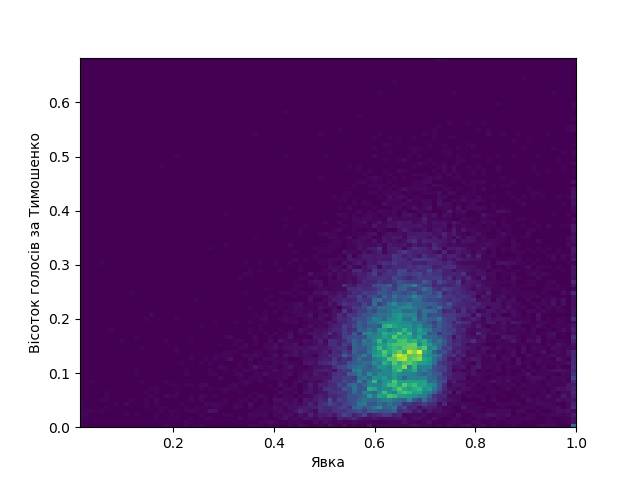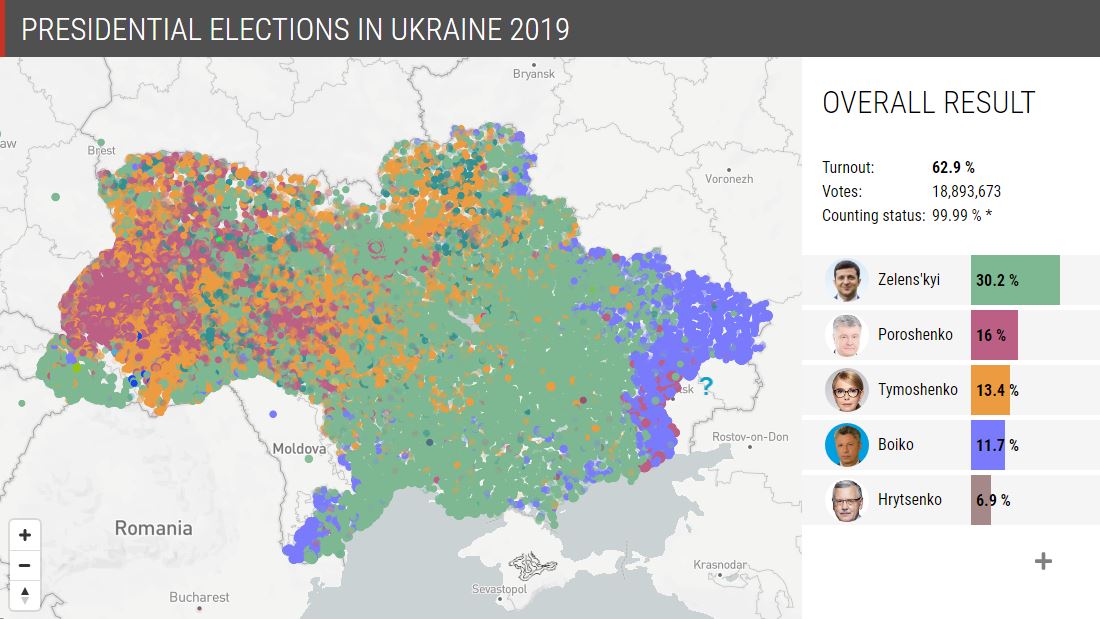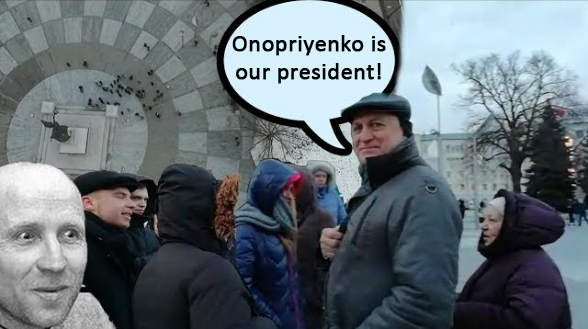Despite Russian scaremongering that Ukrainian presidential elections will be rigged and undemocratic, observers have praised the first round which took place on 31 March as highly democratic. Observers recorded only minor violations in the vote which saw comic actor Volodymyr Zelenskyy take the lead with over 30% and incumbent President Petro Poroshenko come in second with almost 16%.
But in order to be totally sure, we decided to see what electoral statistics tell us about the Ukrainian elections. Statistical methods have been used in many countries to analyze large-scale falsifications, but especially in Russia, where rigged votes have secured the success of President Putin or his United Russia party.

The method is based on the assumption that at polling stations where falsifications take place, extra ballots are stuffed in for candidate A, leading to a rise in the overall turnout. Therefore, in countries with massive voting fraud, a higher than average turnout is correlated with higher than average votes for candidate A.
In a situation where rigging is absent, the distribution of the number of polling stations vs the voter turnout on them follows a Gaussian bell curve. The distribution of the % of votes at a station for a given candidate vs the turnout should also follow a bell curve. As we see on the image above, extra ballots stuffed in for Yedinaya Rossiya have led to cranked-up results for this party at stations with an unusually high turnout. As we see in the graphic below, the distribution of polling stations with regards to their turnout generally does follow a bell curve in democratic elections (however, the Ukrainian presidential elections in 2010 do show signs of falsifications - note the "tail" of the bell curve leaning towards a 100% turnout).

Ukrainian presidential elections 2019, first round
As seen on the interactive map by dekoder, the polling stations where most voters were in favor of Poroshenko and Tymoshenko were located in western Ukraine, Zelenskyy was the favorite of the center and south, and Boiko ruled the east.
To analyze the distribution of the votes, let us examine graphs created by Russian mathematician Sergei Shpilkin, who has for many years been analyzing Russian electoral falsifications. He has kept track of 2019 elections in Ukraine as well using his standard method.
Shpilkin's graphs for entire Ukraine (excluding occupied Crimea and uncontrolled areas of Donbas in eastern Ukraine) represent a nearly perfect Gaussian curve.

Other methods of plotting the data for the entire country done by Ukrainian IT specialist Oleksandr Ivanov show similar results - no large-scale falsifications took place.



If elections were tampered with, the distribution of % of votes vs turnout would look like a "comet with a tail" pointing to the top right corner, as it was in the Russian 2016 elections below:

When the number of votes at a polling station are plotted against the % of votes given for a candidate at this station, Poroshenko's graphic grows three peaks. These peaks are explained by a distinct geographical distribution of his electorate. The peak at 8% represents the east, the peak at 25% - the center, and the peak at 45% - the west of the country.

However, in the Boiko-dominated east, Poroshenko stands out in some districts, as visible on the interactive map. Particularly, they are in the Donetsk Oblast.
The distribution of # of votes vs. voter turnout does not follow a perfect Gaussian curve. It has a "tail," and most of the votes at these anomalous polling stations are for Poroshenko:

One of the explanations proposed by Ukrainian users for this anomaly was that many Ukrainian servicemen voted in the regions near the frontline bordering the Russian puppet Luhansk and Donetsk "puppet republics" in special polling stations created for them. There were 65 such army stations in the Donetsk Oblast and 14 in the Luhansk Oblast. 40% of them voted for Poroshenko, and Zelenskyy got only slightly less. Roman Udot, who works at the Russian independent election monitoring agency Golos, is skeptical about that explanation: after all, no such districts with anomalously high votes for Poroshenko are seen in the Luhansk Oblast, where there were also army stations.
We have compared the anomalously high Poroshenko results in some of the stations in the Donetsk Oblast on the dekoder
map with the voting results of the army polling stations. The latter cannot explain the anomalously high Poroshenko votes in the oblast. Poroshenko's victory at these army polling stations is not nearly as dramatic as Poroshenko's victory at neighboring stations. These results can probably only be explained by electoral fraud. However, the extent of this fraud was not enough to alter the overall course of the election: it does not even show up on the distribution chart for the entire Ukraine.
163 honest cities
In analyzing the overall electoral picture for Ukraine, Shpilkin singled out 171 Ukrainian city with more than 10 polling stations. Of those 171, he finds 163 of them to be "honest cities."
"The elections in Ukraine gave us rich statistical material about details of the results of honestly counted votes in a post-Soviet country. Particularly, we can see how honestly counted votes look like in the city," Shpilkin writes, noting that the voting results in each city are pretty compact in relation to the turnout and results for candidates. "The only exceptions, evidently, are 8 cities in the Donetsk Oblast where there are reasons to suspect falsifications in favor of Poroshenko." Those eight cities are, Shpilkin writes, Bakhmut, Volnovakha, Druzhkivka, Kramatorsk, Krasnohorivka, Myrnohrad, Toretsk.
Shpilkin notes that this method of analyzing electoral fraud was developed by Boris Ovchinnikov, also an electoral researcher from Russia. During the 2011 elections to the Russian Duma, he wrote an article called "184 honest cities." In that election, only 184 of the total 402 cities had distributions of votes which didn't reveal electoral fraud.
Observed falsifications and response
According to the Ukrainian election watchdog Opora, several election violations were observed in the Donetsk Oblast. Particularly, the results between the results on paper in the electoral district #60 differed from the results of the central election committee. As well, the police in Volnovakha received complaints about falsifications at six polling stations. Pretrial investigations are ongoing into two incidents, and six are being studied. Pre-trial investigations are also launched regarding possible falsifications in Bakhmut city. Volyn News
reports about other incidents with violations: in Toretsk, extra ballots were stuffed in. Volyn News provides examples of how exactly the votes were falsified in Bakhmut.
Responding to these reports of violations, the Ukrainian police will increase their presence at stations where anomalous results were observed, Ivan Varchenko, advisor to the Minister of Interior, told at a briefing on 8 April.
As well, he appealed to the other participants of the electoral process to be more diligent during the second round at these stations, explaining that anomalous stations are those where the results for a specific candidate are significantly different from the average in the electoral district or oblast, and this cannot be explained by other factors such as intensive agitation etc.
Read also:
- The ultimate guide to how Ukrainian elections could be falsified
- Statistical method reveals voting fraud of Russia’s pro-Putin party
- Praise for Ukraine’s democracy after first round of elections
- Comedian to face incumbent President in run-off and other takeaways of Ukrainian elections





